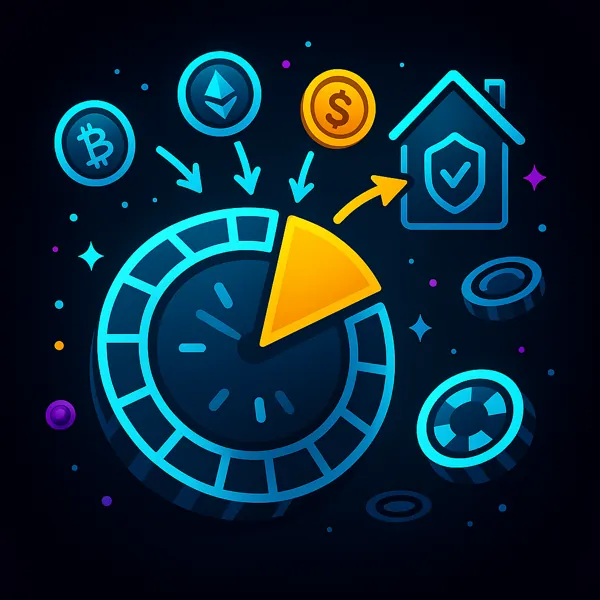If you’ve been in any casino — Vegas, online, or Web3 — you’ve probably heard the phrase: “the house always wins.”But what does that actually mean? The answer is the house edge.
House edge is the secret sauce that keeps casinos profitable in the long run. Even when players hit jackpots or get lucky streaks, the math ensures the house walks away on top.
And yes, that’s true even in Web3 casinos. The blockchain doesn’t erase the house edge — it just makes it more transparent.
Let’s break it down, degen fam style, with simple examples, stats, and why it matters for your bets.
The Simple Definition
House edge = the built-in percentage of every bet the casino expects to keep over time.
Think of it like a tax on your wager. If a game has a 5% house edge, then for every $100 bet across thousands of plays, the casino expects to earn $5 profit.
Players can still win in the short term. You might turn $10 into $1,000 on a crazy slot hit. But across millions of bets, the math guarantees the casino ends up ahead.
Real Examples of House Edge
- Roulette (European wheel) → House edge = 2.7%.
- Roulette (American wheel with two zeros) → House edge = 5.26%.
- Blackjack → As low as 0.5% if you play perfect strategy.
- Slots → Varies a lot, usually 4%–10%.
- Craps → 1.4% on pass line bets, but higher on prop bets.
That’s why casinos can afford free drinks, giant sponsorships, and in Stake’s case, a $100 million deal with Drake. The edge guarantees they profit long-term.
House Edge in Web3
So what changes in Web3 casinos?
- Transparency → In on-chain casinos, the house edge can be coded directly into smart contracts. You can literally read the math.
- Provably Fair → The randomness (dice rolls, spins) is verifiable, so you know the only edge is the house edge, not rigged results.
- Lower edges possible → Some DeFi-style gambling dApps run on razor-thin house edges (1–2%) because they don’t need giant staff or overhead.
- Community distribution → In Web3, part of the house edge can be shared with players, token holders, or liquidity providers. Example: some dApps split 30% of house profits to LPs.
A Simple Example
Let’s say you’re playing dice in a Web3 casino:
- You bet $100 on “roll under 50.”
- Fair odds would pay 2x (because you have 49.5% chance).
- But the casino pays 1.95x instead.
That difference is the house edge. Over millions of rolls, that tiny cut keeps the casino profitable.
In this case, the edge = 2% (because instead of 50/50, payouts are slightly skewed).
Why Casinos Need House Edge
Without house edge, casinos couldn’t survive. They’d rely only on player mistakes or luck — which isn’t sustainable.
In Web3, the house edge isn’t just profit for the operator. It often funds:
- Liquidity providers who bankroll the games.
- Jackpots and progressive prizes.
- Affiliate programs for community referrers.
- Protocol treasury for future development.
So when you gamble in Web3, the edge isn’t just “the casino wins.” It might also be fueling the ecosystem and rewarding other players.
Famous House Edge Stats
- Las Vegas Strip casinos report an average slot house edge of 7%, raking in billions each year.
- Stake.com, Rollbit, and BC.Game don’t always reveal numbers publicly, but dice games often run around 1–2% edges, while slots are 4–6%.
- In 2023, Nevada casinos collected $14.8 billion in gaming revenue, almost all thanks to house edge math.
Can You Beat the House Edge?
Short answer: not in the long run.
- Skill games like poker and blackjack let you reduce the edge, but never erase it.
- Promotions (cashback, rakeback, bonus spins) can temporarily flip expected value, but casinos design them carefully to stay profitable overall.
- Card counting in blackjack works in live games, but online and Web3 casinos shuffle continuously to prevent it.
- Degens hitting memes → yes, you can get lucky. That’s variance, not math-breaking.
The house edge isn’t designed to prevent wins. It just ensures that over millions of bets, the average outcome favors the house.
Web3 Twist: Can Players Be the House?
Here’s where Web3 gets spicy.
Some platforms let players act as the house by providing liquidity. Instead of just betting against the house, you can stake funds into a pool and earn a share of the edge.
Examples:
- Parlay (prediction game) → LPs share house edge profits.
- Polymarket → Market makers earn fees by providing liquidity.
- Decentral Games → Token holders benefit from casino profits in the metaverse.
So in Web3, you don’t always have to play against the house. You can become the house.
Risks to Remember
- The house edge guarantees profit for casinos, but doesn’t guarantee you’ll lose every session. Short-term variance is real.
- Web3 casinos can set unfairly high edges if you don’t check. Always DYOR.
- Some tokens/projects hide the edge in complex reward mechanics. Transparency is key.
Final Word
The house edge is why casinos exist — and why they survive. It’s the invisible tax on every bet that makes sure the house wins long-term.
In Web3, that same edge exists, but with a twist: you can verify it, sometimes it’s smaller, and in many cases, you can even share in it by being a liquidity provider.
So the next time someone says “the house always wins,” you’ll know it’s not just a saying — it’s math. And in Web3, at least you get to see the math for yourself.
Play smart, understand the edge, and wagmi fam 🚀


